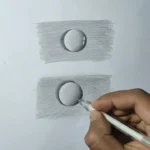Jellyfish lamps, with their mesmerizing and ethereal glow, have become a popular decorative item in homes and offices alike. These unique lighting fixtures, resembling the graceful movements of jellyfish in the ocean, offer a tranquil and captivating visual experience. While their aesthetic appeal is undeniable, the practical aspects of their maintenance, particularly concerning the use of water, often lead to confusion and misinterpretation.
To address the primary question – no, you generally should not put water in a jellyfish lamp. These lamps are designed to mimic the appearance of jellyfish using synthetic materials that float and move in a liquid solution. The specific liquid used is typically a proprietary blend provided by the manufacturer, designed to ensure the optimal movement and longevity of the artificial jellyfish.
Jellyfish lamps provide more than just ambient lighting; they create an atmosphere. The artificial jellyfish, floating in the lamp’s container, are illuminated by LED lights, resulting in a captivating display of colors and movements. The design and materials of these lamps are meticulously chosen to replicate the serene beauty of real jellyfish, making them a focal point in any setting.
## Importance of Correct Usage
Jellyfish lamps, a fusion of art and technology, have captivated the attention of many due to their unique ability to bring a piece of the ocean’s serenity into indoor spaces. However, their charm and functionality heavily rely on correct usage. Misuse or misunderstanding of how these lamps work can lead to diminished aesthetic appeal, reduced functionality, and potentially even damage to the lamp. This underscores the importance of understanding the intricacies of jellyfish lamps, particularly concerning the usage of liquids within them.
## Jellyfish Lamps Explained
### Definition and Types
Jellyfish lamps are decorative lighting fixtures designed to emulate the graceful movements of jellyfish in a liquid-filled container. They come in various types, from small desktop models to larger freestanding units. Some are simplistic, focusing solely on the movement of color-changing artificial jellyfish, while others are more elaborate, featuring enhanced lighting effects and customizable settings.
### Working Mechanism
At the heart of a jellyfish lamp’s working mechanism is a combination of LED lighting, artificial jellyfish made from silicone or similar materials, and a liquid medium. The lamp uses a small motor to create a gentle current in the liquid, allowing the artificial jellyfish to float and move in a lifelike manner. LED lights positioned at the base of the lamp illuminate the jellyfish, creating a mesmerizing and soothing light display.
### Popularity and Usage
Jellyfish lamps have gained popularity for their therapeutic effects and aesthetic appeal. They are commonly used in homes, offices, and therapy centers for their calming effect, often contributing to stress reduction and relaxation. The ability of these lamps to create a tranquil atmosphere makes them a favorite for meditation spaces and sensory rooms.
## The Water Debate in Jellyfish Lamps
### Common Misconceptions
A prevalent misconception is that jellyfish lamps can be filled with regular tap water. This misunderstanding stems from the assumption that since real jellyfish live in water, artificial ones in lamps should too. However, this is not the case, as the specific requirements of these lamps extend beyond what plain water can provide.
### Importance of Manufacturer’s Instructions
Adhering to the manufacturer’s instructions is crucial for the optimal functioning of a jellyfish lamp. These guidelines provide specific information on the type of liquid to use, how to set up the lamp correctly, and how to maintain it over time. Ignoring these instructions can lead to poor performance of the lamp and potentially damage its components.
### Why Water is a Concern
#### Material and Design Considerations
The materials used in the construction of jellyfish lamps are selected to interact harmoniously with the manufacturer-provided liquid. Water, with its varying mineral content and potential for microbial growth, can react adversely with these materials, leading to clouding, discoloration, or damage.
#### Impact on Lamp Functionality
Using water instead of the recommended liquid can significantly impact the functionality of the lamp. Water may not provide the correct density and viscosity needed for the artificial jellyfish to move realistically. This can result in sluggish or unnatural movements, diminishing the lamp’s visual appeal.
## Alternatives to Water in Jellyfish Lamps
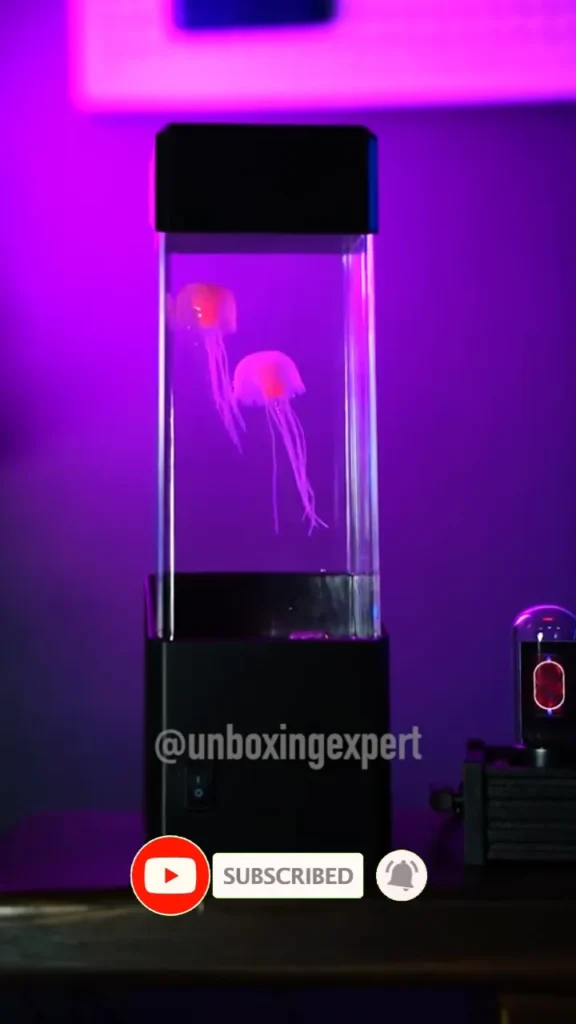
### Manufacturer-Provided Liquid
Most jellyfish lamps come with a manufacturer-provided liquid specifically formulated for use in these lamps. This liquid is designed to support the proper movement and appearance of the artificial jellyfish, and it usually ensures clarity, the right density, and compatibility with the lamp’s materials.
### DIY Solutions and Risks
While some users may be tempted to create their own liquid solutions, this comes with risks. Homemade mixtures may not provide the correct properties needed for the lamp to function properly and could lead to damage or safety hazards.
### Comparing Liquid Options
#### Pros and Cons of Different Fluids
Various fluids have been experimented with by enthusiasts, ranging from distilled water to glycerin mixtures. Each of these options comes with its own set of pros and cons. For instance, distilled water might be safer than tap water but still lacks the necessary properties for optimal jellyfish movement.
#### Safety and Longevity
Safety and longevity of the lamp are paramount considerations when choosing a liquid. The wrong choice can not only compromise the lamp’s functionality but also pose a safety risk, especially if the liquid interacts negatively with the lamp’s electrical components. Adhering to the recommended liquid choice ensures both safety and longevity of the lamp.
In conclusion, understanding the nuances of jellyfish lamps, especially regarding the appropriate use of liquids, is essential for maintaining their beauty and functionality. By adhering to manufacturer guidelines and avoiding common misconceptions, users can ensure their jellyfish lamps continue to provide a tranquil and mesmerizing visual experience.
## Setting Up Your Jellyfish Lamp
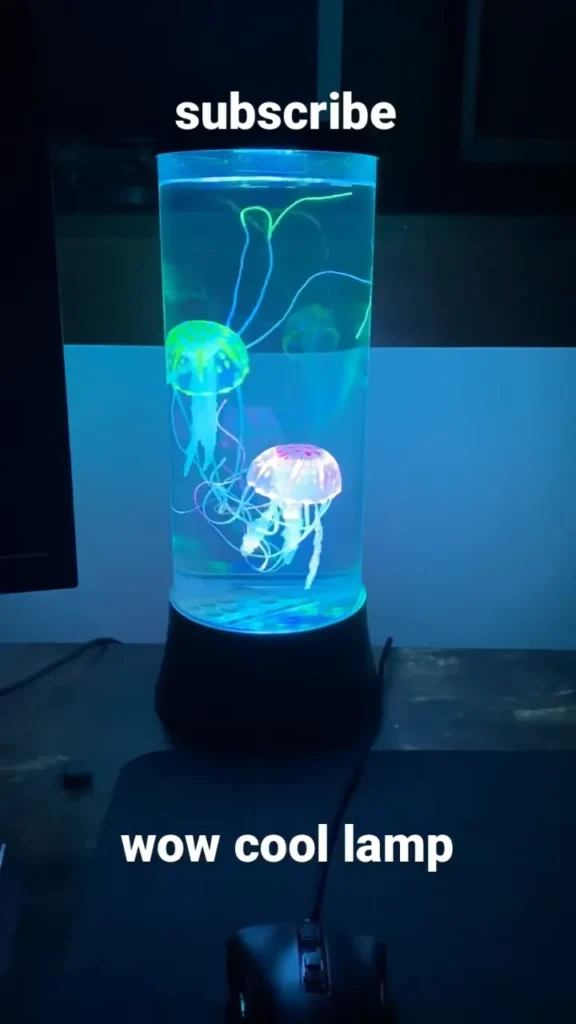
Jellyfish lamps are a unique and captivating addition to any space, providing a serene and mesmerizing visual experience. Proper setup is crucial to ensure the lamp functions correctly and safely. This section provides a detailed guide on how to set up your jellyfish lamp correctly, ensuring optimal performance and longevity.
### Step-by-Step Guide
1. **Unpack Carefully**: Begin by carefully unpacking your jellyfish lamp and its components. This often includes the lamp base, cover, artificial jellyfish, and liquid solution.
2. **Assemble the Lamp**: Follow the manufacturer’s instructions to assemble the lamp. This usually involves placing the artificial jellyfish into the lamp container and securing any detachable parts.
3. **Add the Liquid**: Pour the manufacturer-provided liquid into the lamp container. It’s essential to use only the recommended liquid to ensure the proper functioning of the jellyfish.
4. **Positioning the Jellyfish**: Gently place the artificial jellyfish in the liquid. They might take a while to fully expand and start floating properly.
5. **Powering the Lamp**: Connect the lamp to a power source. Most jellyfish lamps are powered via a standard electrical outlet or USB port.
6. **Initial Operation**: Turn on the lamp and allow it to run for a few hours. This helps the jellyfish acclimate to the environment and start moving more fluidly.
### Tips for Best Performance
– **Avoid Direct Sunlight**: Placing the lamp in direct sunlight can cause discoloration and affect the liquid’s properties.
– **Room Temperature**: Keep the lamp in a room-temperature environment for optimal movement of the jellyfish.
– **Gentle Movement**: Do not shake or move the lamp vigorously as this can damage the internal mechanism and the jellyfish.
## Maintenance and Care
Regular maintenance is key to keeping your jellyfish lamp in good condition and prolonging its lifespan. This includes cleaning procedures and troubleshooting common issues.
### Regular Cleaning Procedures
– **Exterior Cleaning**: Wipe the outside of the lamp with a soft, dry cloth to remove dust and fingerprints.
– **Interior Cleaning**: Occasionally, the inside of the lamp may need cleaning. Carefully empty the liquid and remove the jellyfish. Clean the interior gently with a soft cloth, avoiding harsh chemicals.
### Troubleshooting Common Issues
– **Jellyfish Not Floating**: If the jellyfish are not floating properly, ensure the liquid is at the correct level and the jellyfish are fully expanded.
– **Cloudy Liquid**: Cloudiness can occur due to impurities. Replace the liquid with a fresh batch from the manufacturer.
– **Non-Functional Light**: Check the power source and connections if the lamp’s light is not working.
## Jellyfish Lamp Safety Tips
Safety is paramount when dealing with electrical devices like jellyfish lamps. Following safety guidelines ensures the lamp operates without risks.
### Electrical Safety
– **Proper Outlets**: Always plug the lamp into a proper electrical outlet and avoid overloading sockets.
– **Cord Management**: Keep the power cord away from high-traffic areas to prevent tripping or damage to the lamp.
### Liquid Handling and Spills
– **Spill Prevention**: Place the lamp in a stable location where it is unlikely to be knocked over.
– **Spill Response**: In case of a spill, unplug the lamp immediately and clean up the liquid to prevent any potential hazards.
## Best Practices for Longevity
Maximizing the lifespan of your jellyfish lamp involves more than just proper setup and regular maintenance. It also includes considering the lamp’s placement and avoiding common mistakes.
### Ideal Placement
– **Stable Surface**: Place the lamp on a stable, flat surface to prevent tipping.
– **Away from Electronics**: Keep the lamp away from other electronic devices to avoid electrical interference or damage in case of a spill.
### Avoiding Common Mistakes
– **Using the Wrong Liquid**: One of the most common mistakes is using tap water or other liquids instead of the manufacturer-provided solution.
– **Excessive Handling**: Frequently moving or handling the lamp can disturb the jellyfish and affect the lamp’s internal mechanics.
– **Ignoring Manufacturer’s Instructions**: Always refer to and follow the manufacturer’s guidelines for setup, use, and maintenance.
Following these guidelines ensures that your jellyfish lamp remains a captivating and safe feature in your space. Regular care and adherence to best practices will keep your lamp functioning beautifully, providing a peaceful and soothing ambiance for years to come.
## The Environmental Aspect
The surge in popularity of jellyfish lamps brings with it a responsibility to consider their environmental impact. This aspect encompasses everything from the materials used in their construction to their energy consumption and eventual disposal. As consumers become increasingly environmentally conscious, the ecological footprint of these decorative items is a growing concern.
### Eco-Friendly Practices
To mitigate environmental impact, eco-friendly practices in the production and usage of jellyfish lamps are essential. Manufacturers are now more aware of the need to use sustainable materials. These can include recycled plastics or biodegradable materials for the lamp structure and jellyfish replicas. Furthermore, LED lights, which are known for their low energy consumption and long lifespan, are a standard in these lamps, making them more energy-efficient and environmentally friendly.
### Disposal and Recycling
When a jellyfish lamp reaches the end of its life, proper disposal is crucial. The environmental responsibility doesn’t end with the purchase; it extends to how the product is disposed of. Many components of these lamps can be recycled, such as the plastic parts and electronic components. Consumers should be encouraged to dismantle the lamps and dispose of each part in accordance with local recycling guidelines.
## Innovations in Jellyfish Lamps
The world of jellyfish lamps is not static; it is continuously evolving with new innovations and trends. These advancements are not just in the realm of aesthetics but also in functionality and sustainability.
### Latest Trends and Features
Recent trends in jellyfish lamps focus on enhancing the user experience and reducing environmental impact. This includes incorporating smart technology, allowing users to control the lamp’s settings via smartphone apps. Features like adjustable light intensity, color selection, and movement patterns are becoming standard. Additionally, there’s a trend towards more compact and efficient designs, reducing material use and packaging waste.
### Future Prospects
Looking ahead, the future of jellyfish lamps seems to align closely with advancements in sustainable materials and smart technology. We might see innovations like solar-powered jellyfish lamps or biodegradable liquids that perfectly mimic the density and viscosity required for the artificial jellyfish to float. The integration of AI to create more lifelike movements and interactive features is also a possibility that could redefine the user experience.
## Recap of Key Points
Reflecting on the journey through the world of jellyfish lamps, several key points emerge:
– **Correct Usage**: The importance of using the lamp as intended by the manufacturer, especially regarding the type of liquid used.
– **Maintenance and Care**: Regular cleaning and maintenance are crucial for the lamp’s longevity and performance.
– **Safety Considerations**: Adherence to safety guidelines, particularly concerning electrical components and liquid handling, is paramount.
– **Environmental Responsibility**: From eco-friendly manufacturing practices to responsible disposal and recycling, the environmental aspect is an integral part of the conversation around jellyfish lamps.
## Encouraging Responsible Usage
In conclusion, while jellyfish lamps offer a unique and tranquil decorative element, they come with responsibilities. As users and enthusiasts of these lamps, it is crucial to recognize the importance of using them responsibly. This involves following the manufacturer’s guidelines, ensuring proper maintenance, being conscious of safety practices, and considering the environmental impact throughout the lamp’s lifecycle. By embracing these responsibilities, we can continue to enjoy the beauty and serenity of jellyfish lamps while minimizing their footprint on our planet.
What detergent do you put in jellyfish lamp?
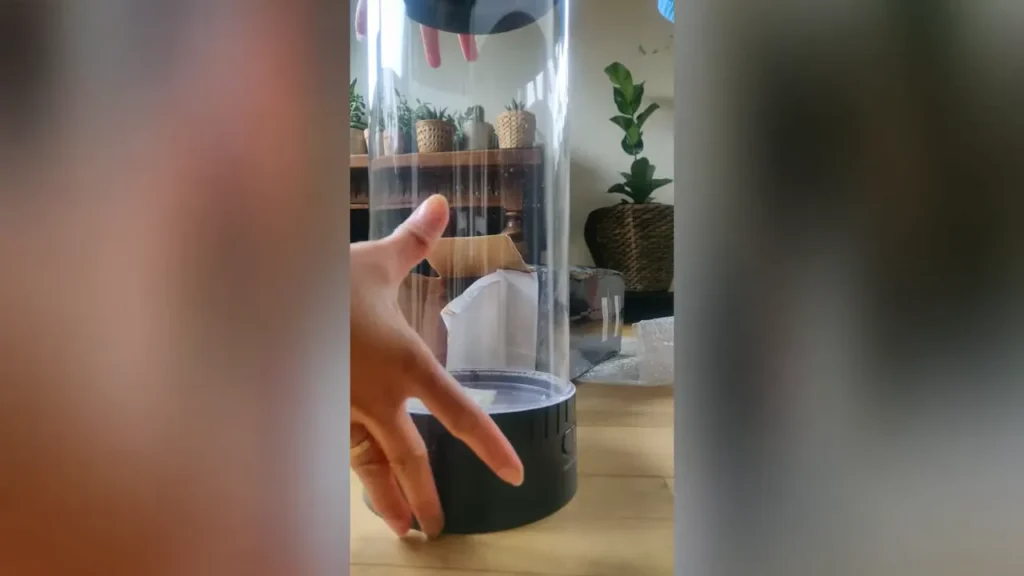
You should not use any detergent in a jellyfish lamp. Jellyfish lamps are designed to be used with a specific type of liquid, usually provided by the manufacturer, which is specially formulated to maintain the correct viscosity and density for the artificial jellyfish to float and move properly.
Using detergent or any other household liquids like water, oil, or soap can disrupt the delicate balance required for the lamp to function correctly. It can lead to issues such as clouding of the liquid, damage to the mechanical parts, or even malfunctioning of the lamp. Always follow the manufacturer’s instructions regarding the filling and maintenance of your jellyfish lamp to ensure its longevity and proper functioning.

## FAQs
### What Liquid is Used in a Jellyfish Lamp?
Jellyfish lamps typically use a special liquid provided by the manufacturer. This liquid is formulated to support the movement and appearance of the synthetic jellyfish, ensuring they float and drift realistically. It’s important to adhere to the manufacturer’s guidelines for the best results and longevity of the lamp.
### Can I Use Tap Water in My Jellyfish Lamp?
It is not recommended to use tap water in jellyfish lamps. Using water, especially from the tap, can lead to cloudiness, bacterial growth, and potential damage to the lamp’s mechanics. Always follow the manufacturer’s instructions regarding the appropriate liquid to use.
### How Do I Maintain My Jellyfish Lamp?
Maintaining a jellyfish lamp involves regular cleaning and ensuring the use of the correct liquid. Clean the interior gently to avoid damage to the lamp or the artificial jellyfish. Check for any instructions provided by the manufacturer regarding the maintenance routine.
### Are Jellyfish Lamps Safe for Children’s Rooms?
Jellyfish lamps are generally safe for children’s rooms, provided they are placed out of reach. The lamp should be positioned securely to prevent tipping, and children should be supervised to ensure they do not attempt to open the lamp or touch the contents.
### Can I Customize the Color of My Jellyfish Lamp?
Most jellyfish lamps come with customizable LED lights, allowing you to select or change the color according to your preference. This feature adds to the lamp’s versatility as a decorative piece in various settings.
## Conclusion
Jellyfish lamps offer a unique blend of art and technology, creating a peaceful and enchanting ambiance. While they capture the essence of the ocean’s wonders, it is crucial to use them correctly to maintain their beauty and functionality. Remember, these lamps require a specific liquid, not water, to ensure the artificial jellyfish move as intended.
Their maintenance, though minimal, is vital for their longevity. Regular cleaning, using the correct liquid, and following the manufacturer’s instructions will keep your jellyfish lamp in prime condition, ensuring it continues to provide a soothing and delightful display.
Finally, jellyfish lamps are more than just a lighting fixture; they are a statement piece that can transform the mood of any room. Whether in a home, office, or therapeutic setting, these lamps offer a unique visual experience, blending the allure of nature with the convenience of modern design.
